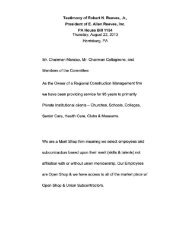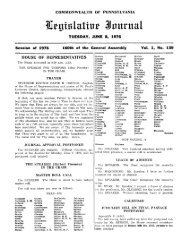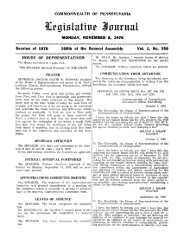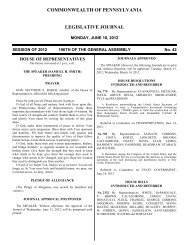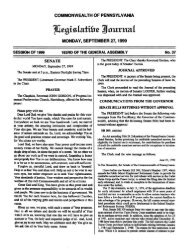Statement of Ronald B. Herberman, MD Chairman of Board ...
Statement of Ronald B. Herberman, MD Chairman of Board ...
Statement of Ronald B. Herberman, MD Chairman of Board ...
You also want an ePaper? Increase the reach of your titles
YUMPU automatically turns print PDFs into web optimized ePapers that Google loves.
~<br />
1 News ?<br />
Carcinogenicity <strong>of</strong> radi<strong>of</strong>requency electromagnetic fields<br />
In May, 2011, 30 scientrsts from<br />
14 coumries met atthe Internattonal<br />
Agency for Research on Cancer<br />
(IARC) In Lyon, France, to assess the<br />
carcinogenicity <strong>of</strong> radi<strong>of</strong>requency<br />
electromagnettc fields (RF-EMF)<br />
These assessmentsw~ll bepubllshed as<br />
Volume 102 <strong>of</strong>the IARC Monographs'<br />
Human exposures to RF-EMF<br />
(frequency range 30 kHz300 GHz) can<br />
occur from use <strong>of</strong> personal devices (eg,<br />
mobile telephones, cordless phones,<br />
Bluetooth, and amateur radios).<br />
from occupational sources (eg, hlgh.<br />
frequency d~elearic and lnduct~on<br />
heaters, and high-powered pulsed<br />
radars), and from envimnmental<br />
sources such as mobile-phone base<br />
statlow, broadcast antennas, and<br />
med~cdl applications. For workers,<br />
most emosure to RF-EMF comes from<br />
near-fierd sources, whereas thegeneral<br />
populat~on receives the h~ghest<br />
exposure from transmitters dose to<br />
the bodv, such as handheld devices like<br />
.<br />
mobile telephones. Exposure to high.<br />
power sources at work might involve<br />
highercumulative RF energy deposited<br />
into the body than exposure to mobile<br />
phones, butthe local energydeposited<br />
in the brain is generally less. Typical<br />
exposures to the brain from ro<strong>of</strong>top<br />
or tower-mounted mobilephone base<br />
stationsandfmmNandradibstations<br />
are several orders <strong>of</strong> magnitude<br />
lower than those from global system<br />
for mobile communications (GSM)<br />
handsets. The average exposure<br />
from use af digital enhanced cordless<br />
telecommunications (DECT) phones<br />
is around five times lower than that<br />
measured for GSM phones, and<br />
third-generation (3G) phones em<br />
it, on average, about 100 times less<br />
RF energy than GSM phones, when<br />
signals are strong. Similarly, the<br />
average output power <strong>of</strong> Btuetooth<br />
wireless hands-free krts is estimatedto<br />
be around 100 times lowerthan that<br />
<strong>of</strong> mobilephones.<br />
EMF5 genkrated by RF sources<br />
couple with the body, resulting in<br />
Induced electric and magnetic fields<br />
andassociated currents lns~de tissues.<br />
The most ~mportant factors that<br />
determ~ne the Induced fields are<br />
the distance <strong>of</strong> the source from the<br />
body and the output power level.<br />
Additionally, the efficiency <strong>of</strong> coupling<br />
and resulting field distribution inside<br />
the body strongly depend on the<br />
frequency, polarisation, and direction<br />
<strong>of</strong> wave incidence on the body, and<br />
anatomical features <strong>of</strong> the exposed<br />
person, including height, hodymass<br />
index, posture, and dielectric<br />
properties <strong>of</strong> the tissues. Induced<br />
fields within the body are highly nonun~form,<br />
varytng over several orders <strong>of</strong><br />
masn~tude, with local hotseotr<br />
Holding a mobile phone to the ear<br />
to makea voice call can result in high<br />
specific RF energy absorption-rate<br />
(SAR) values in the brain, depending<br />
on the design and position <strong>of</strong> the<br />
phone and its antenna in relation to<br />
the head, how the phone is held, the<br />
anatomy <strong>of</strong>the head, andthe quality<br />
<strong>of</strong> the link between the base station<br />
and phone. When used by children,<br />
the average RF energy deposition<br />
is two times higher in the brain and<br />
up to ten times higher in the bone<br />
marrow <strong>of</strong> the skull, compared with<br />
mobile phone use by adults? Use<br />
<strong>of</strong> hands-free kits lowers exposure<br />
to the brain to below 10% <strong>of</strong> the<br />
exposure from use at the ear, but it<br />
might increase exposure to other<br />
parts<strong>of</strong>the body?<br />
Epidemiological evidence for an<br />
association between RF-EMF and<br />
cancer comes from cohort, cash<br />
control, and time-trend studies. The<br />
populations in these studies were<br />
exposed to RF-EMF in occupational<br />
settings. from sources in the general<br />
environment, and fromuse<strong>of</strong>wireless<br />
(mobile and cordless) telephones.<br />
which is the most extensively studied<br />
exposure source. One cohort study'<br />
and five case-control studiesrg were<br />
judged by the Working Group to<br />
<strong>of</strong>fer potentially useful information<br />
@<br />
regarding associations between use <strong>of</strong><br />
wireless phones andglioma.<br />
The cohort study' inciuded2V cases<br />
<strong>of</strong> glioma among 420095 subscribers<br />
t~twoDanishmobilephonecompanies<br />
between 1982 and 1995. Glioma<br />
incidencewas nearthenationalaverage<br />
for the subscribers. In this study,<br />
reliance on subscription to a mobile P&II,~~O~I~~~<br />
phone ~rovider, as a surrogate for J""*ZI.~OI~<br />
mobile phone use, could have resulted ~~$'~~~~~~<br />
in considerable mivlassification in fama,eanthclrRC<br />
ewsure asses5ment Three early M ~ ~ ~ ~ ~ ~ ~ , . .<br />
case-control studies*' encompassed hwiimo~os.phria.~~vh~iar~~r~<br />
a period when mobile phone use was Upcominpmtt~tingr<br />
low, userstypically had low cumulative oal~-~a.mn<br />
erposurer, tlme since first use <strong>of</strong> a ~ ~ ~ ; ~ ; ~ t ~ ~ - ~ ~ ~<br />
moblle phone was short, and effect<br />
estimates were generally imprecise; P.bl.142iu<br />
the Working Group considered these ~o~wm~uiiua~[wqo,auc.ard<br />
studies less informative. Tme.trend ~~~~~mllvi~~~~liiundmal~riri<br />
analyses did not show an increased JU"S-u.zml<br />
rate<strong>of</strong> brain tumoursafterthe increase ~ ~ / ~ ~ ~<br />
in mobiie phone use. However, these MonaJnph<br />
roup<br />
studies have rubstantial limitations ~ t ~ b ~ ~<br />
because most<strong>of</strong>theanalysesexamined I Sam~-CM~lUSA):<br />
trends until the early 2000s only. Such ~ ~ ~ , ~ ~ ~ ~ o ~ ' ~ u<br />
analyses are uninformative If excess Pva~uraonri,r~.rrth..ve<br />
risk only manifests more than a decade 18elsiuml:l Siemia~Xi.<br />
after phone use beg~ns, or if phone ~ ~ ~ ~ " s ~ " , ~ ~ ~ , , m<br />
use only affects a small proportion <strong>of</strong> (finland) R ~ E S . 1 ~ iaore<br />
cases-eq.the mostheavllyemosed, . . or (Fiance) M Btettnw<br />



